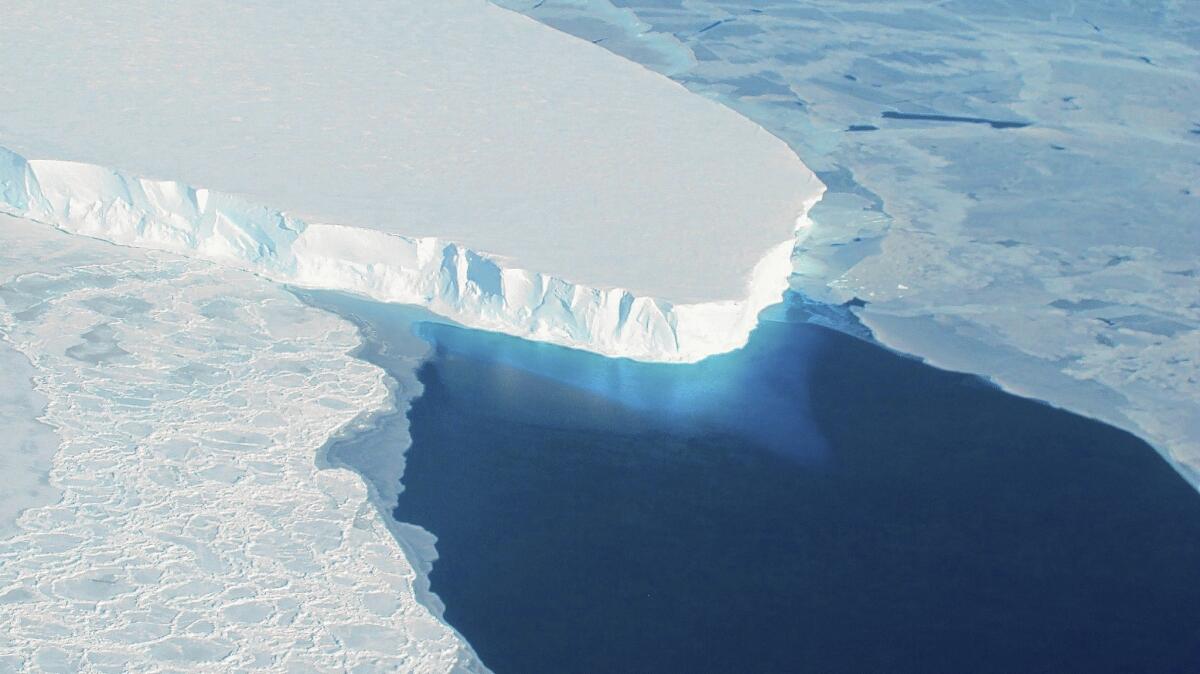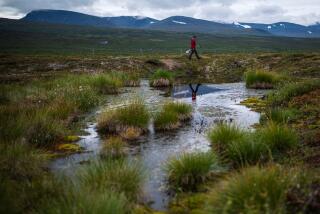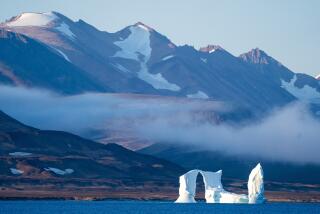Irreversible collapse of Antarctic glaciers has begun, studies say
- Share via
A slow-motion and irreversible collapse of a massive cluster of glaciers in Antarctica has begun, and could cause sea levels to rise across the planet by another 4 feet within 200 years, scientists concluded in two studies released Monday.
Researchers had previously estimated that the cluster in the Amundsen Sea region of the West Antarctic Ice Sheet would last for thousands of years despite global climate change. But the new studies found that the loss is underway now as warming ocean water melts away the base of the ice shelf, and is occurring far more rapidly than scientists expected.
The warming water is tied to several environmental phenomena, including a warming of the planet driven by emissions from human activity and depleted ozone that has changed wind patterns in the area, the studies found.
“There is no red button to stop this,” said Eric Rignot, a UC Irvine professor of Earth system science and the lead author of one of the studies, conducted with NASA’s Jet Propulsion Laboratory and scheduled for publication in a journal of the American Geophysical Union.
The six glaciers have passed “the point of no return,” Rignot said, which means that total collapse — the melted retreat of the glaciers — cannot be prevented. “The only question is how fast it’s going to go.”
There is no red button to stop this... The only question is how fast it’s going to go.
— Eric Rignot, a UC Irvine professor
Antarctica, surrounding the South Pole, is the largest mass of ice on the planet, containing an estimated 80% of the world’s fresh water. Its scale is difficult to fathom. One environmental foundation said that if you loaded the ice onto cargo ships and started counting the vessels, one per second, it would take 860 years before you were finished counting.
The loss of even a portion of that ice would have consequences across the globe. Scientists have surmised its possibility for decades, and have braced for confirmation, which in effect arrived Monday.
For the UCI-JPL study, scientists used 40 years’ worth of measurements, much of it data from satellite radar systems that can measure changes on Earth’s surface to within a quarter of an inch.
The data was used to measure the precise location of the glaciers’ so-called grounding lines — the point at which glaciers connect to a land mass. It is at this nexus where warmer ocean water encounters the ancient ice and causes it to retreat.
The problem compounds itself in several ways, scientists said.
The more grounding lines recede, for instance, the less glaciers weigh, which lifts them farther off Earth’s bedrock, which allows even more warm water to erode their foundations. Similarly, as the glaciers retreat into deeper portions of the ocean, their ice faces become steeper, rendering them increasingly unstable and increasingly exposed to warmer water.
The second study, conducted by researchers at the University of Washington and scheduled for publication in the journal Science, focused largely on one of the six glaciers, the Thwaites Glacier. Scientists attempted to pinpoint how quickly the giant Thwaites might disappear altogether, a development that by itself could cause global sea levels to rise by 2 feet.
That amount of sea level rise would have a chaotic impact.
An unrelated study this year of the potential effect in Southern California, for instance, said that a sea level rise more modest than that would threaten portions of the Pacific Coast Highway, imperil coastal infrastructure such as power plants and wastewater treatment plants and exacerbate tides and storm surges in low-lying communities such as Venice and San Pedro.
The University of Washington study used satellite measurements and computer models to determine that the Thwaites could melt in as little as 200 years, or the melting could take as long as 1,000 years. Ian Joughin, a university glaciologist and the lead author of that study, said the most likely scenario is at the lower end of that range.
“There is quite a bit of ongoing destabilization,” he said, and the disappearance would begin slowly and accelerate over time, with no available “stabilizing mechanism.”

The Thwaites is an important test case because it is viewed as particularly unstable, and a linchpin for the stability of the rest of the West Antarctic Ice Sheet. As goes the Thwaites, many scientists fear, so goes the rest of the ice sheet — its disappearance would undermine the entire glacial system, exposing many more miles of grounding lines to the warming ocean water.
“You can’t just remove this glacier cleanly,” Joughin said. “You pull one part out, the rest will move into the void.”
If the entire ice sheet disappeared, the global sea level could rise by a catastrophic 15 feet.
“Eventually, this could lead to the demise of ice across Antarctica,” Rignot said.
The scientists were careful to point out that an inevitability is not cause for surrender. The 800-year range for the time frame is enormous, they pointed out — and was driven by computer models that “turned up the knob and turned down the knob” on global temperatures driven by climate change, Joughin said. More emissions mean more melting and faster collapse, the researchers said, but the inverse is true, too.
“Eight hundred years is a long time,” Joughin said.
A significant reduction in emissions and other safeguards against climate change could extend the collapse closer to the upper end of that range. Think of the technological advances in the last 800 years to gauge how much that time could help in safeguarding coastal areas from the impact of rising sea level, Joughin said.
“The system really is going down,” Rignot said. “How fast it is going to go is critical.”







